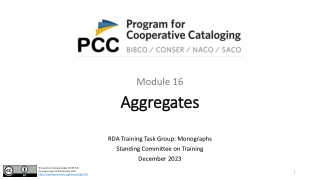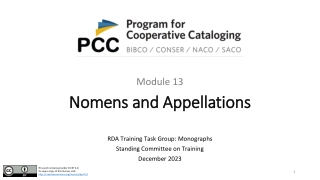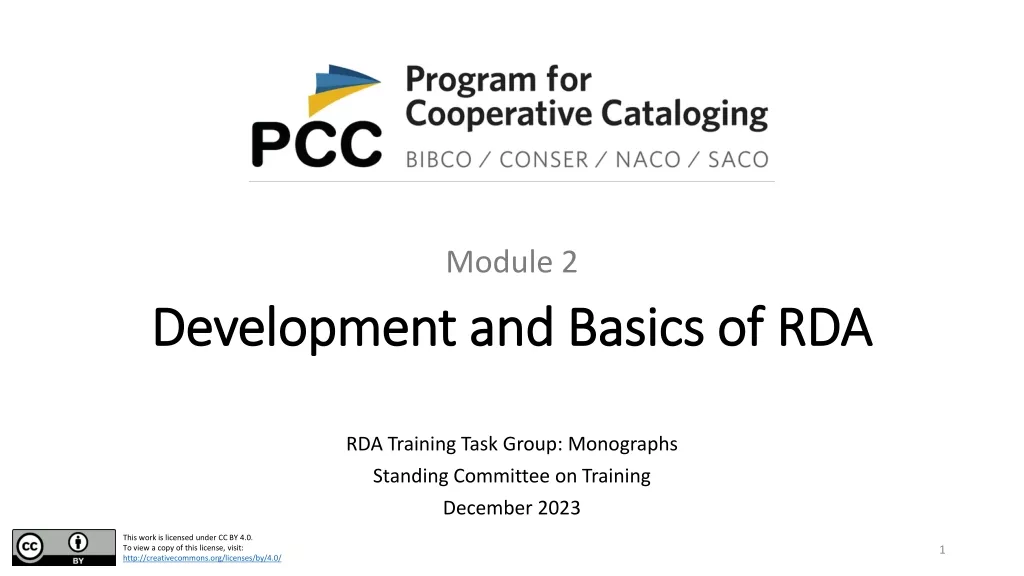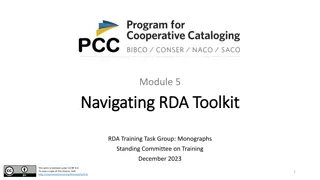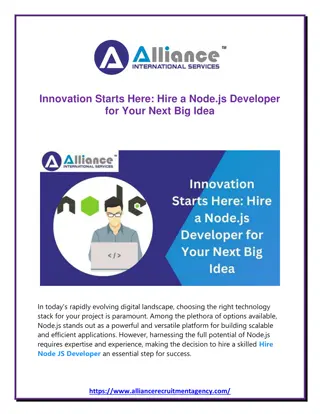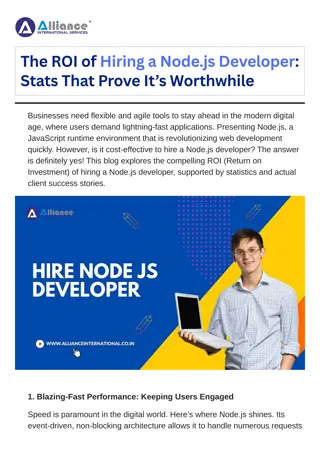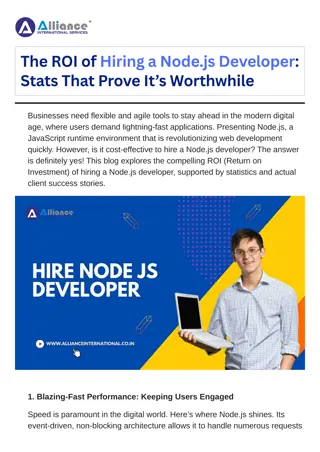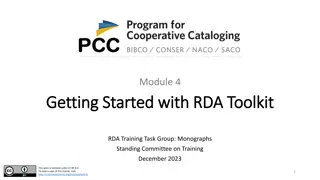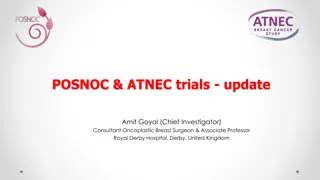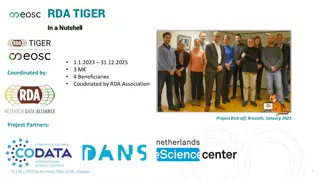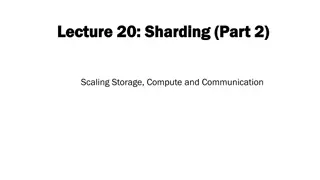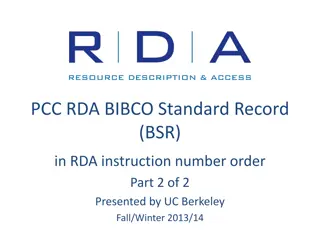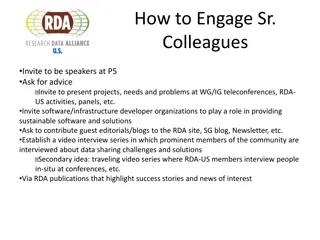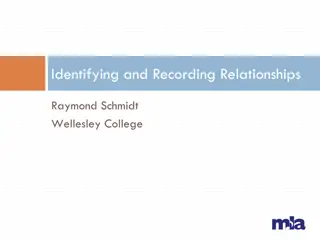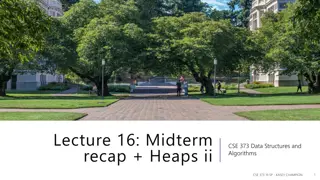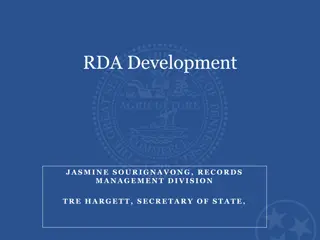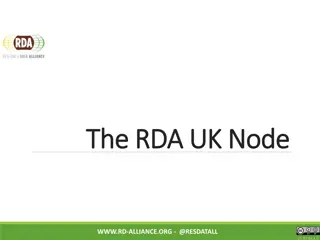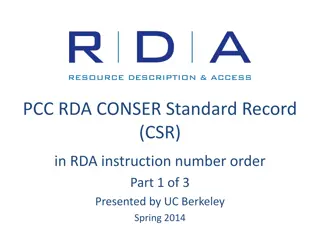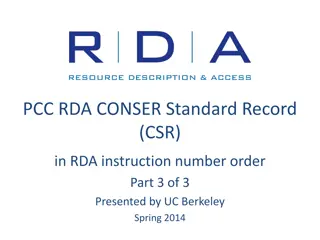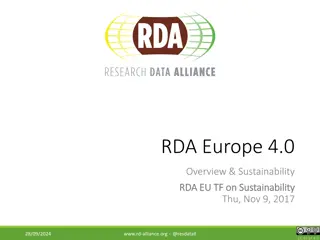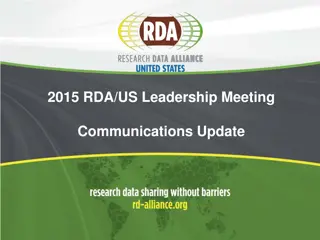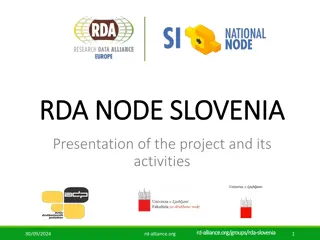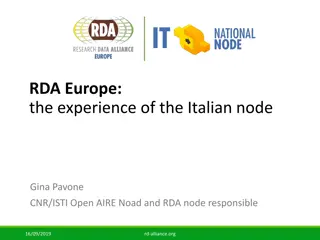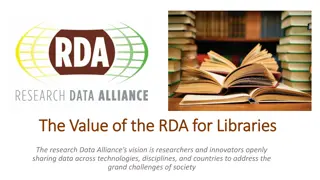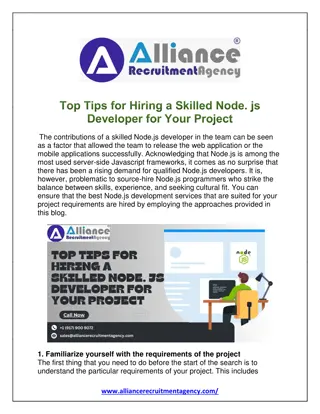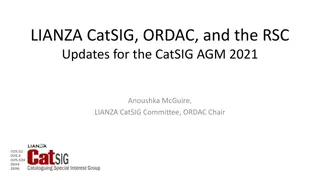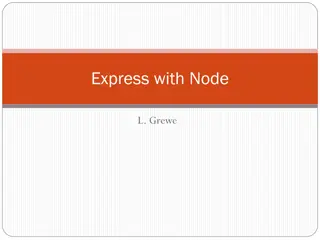Understanding Aggregates in RDA Training: A Comprehensive Overview
Explore the concept of aggregates in RDA training through this detailed module covering types of aggregates, LRM model, user-driven examples, and considerations in describing aggregates. Gain insights into collection, augmentation, and parallel aggregates with practical scenarios.
1 views • 40 slides
Graph Machine Learning Overview: Traditional ML to Graph Neural Networks
Explore the evolution of Machine Learning in Graphs, from traditional ML tasks to advanced Graph Neural Networks (GNNs). Discover key concepts like feature engineering, tools like PyG, and types of ML tasks in graphs. Uncover insights into node-level, graph-level, and community-level predictions, an
3 views • 87 slides
Understanding Nomen Entity in RDA Training Module
Explore the development of the Nomen entity in RDA training, differentiating nomen and nomen strings, identifying RDA elements for describing a nomen, and examining relationship elements linking RDA entities with nomens. Delve into the origins and attributes of nomens as defined in FRBR and FRAD sta
1 views • 48 slides
Evolution of Cataloging Standards: From Cutter's Objects of the Catalog to RDA Development
The evolution of cataloging standards reflects a rich history dating back to the 19th century, from Cutter's Objects of the Catalog to the development of official RDA. Key milestones include the 3R Project, LRM, RDA Registry, and the shift in cataloging rules driven by changing user needs and digita
5 views • 38 slides
RDA Toolkit User Guide: Navigating Module Features
Explore the comprehensive RDA Toolkit user guide to understand the basic organization, entity and element pages structure, and various features available for navigating the RDA Toolkit effectively. Learn to access and utilize Policy Statements and Metadata Guidance Documentation effortlessly.
4 views • 120 slides
Innovation Starts Here Hire a Node.js Developer for Your Next Big Idea
Discover the key benefits of hiring a Node.js developer for your project. From real-time applications to scalable solutions, unlock the power of Node.js expertise to elevate your development process and drive success.
5 views • 6 slides
The ROI of Hiring a Node.js Developer - Stats That Prove It’s Worthwhile
Explore the ROI of hiring a Node.js developer. Learn how Node.js boosts efficiency, scalability, and performance, driving better user experiences and higher conversion rates. Discover why it's a smart investment. For more information, visit: \/hire-node-js-developer. #hirenodejsdeveloper
1 views • 5 slides
The ROI of Hiring a Node.js Developer - Stats That Prove It’s Worthwhile
Explore the ROI of hiring a Node.js developer. Learn how Node.js boosts efficiency, scalability, and performance, driving better user experiences and higher conversion rates. Discover why it's a smart investment. For more information, visit: \/hire-node-js-developer. #hirenodejsdeveloper
0 views • 5 slides
Accessing and Logging In to the RDA Toolkit
Explore the RDA Toolkit, an integrated online product for cataloging-related resources. Learn how to access and log in through IP authentication or institution login to create a user profile effectively.
1 views • 18 slides
POSNOC & ATNEC Trials Update by Amit Goyal: Investigating Axillary Treatment in Breast Cancer
POSNOC (Positive Sentinel Node) and ATNEC trials are investigating the effectiveness of axillary treatment in women with early-stage breast cancer having metastases in one or two sentinel nodes. Led by Chief Investigator Amit Goyal in the UK, this randomized controlled trial compares adjuvant therap
1 views • 21 slides
Overview of Policy Service Node (PSN) Architecture
The Policy Service Node (PSN) architecture consists of various key components such as Policy Administration Node (PAN), Monitoring Node (MnT), Inline Posture Node (IPN), and Multi-Function Node. These components work together to enable efficient policy management and network monitoring within a netw
1 views • 5 slides
RDA TIGER - Internationalization Support for Research Data Alliance Working Groups
RDA TIGER, through its services, facilitates the internationalization of EOSC developments by supporting Research Data Alliance Working Groups. It provides assistance in initiating and running WG, engaging international partners, communicating activities, offering small grants, and helping create im
0 views • 7 slides
Primal-Dual Algorithms for Node-Weighted Network Design in Planar Graphs
This research explores primal-dual algorithms for node-weighted network design in planar graphs, focusing on feedback vertex set problems, flavors and toppings of FVS, FVS in general graphs, and FVS in planar graphs. The study delves into NP-hard problems, approximation algorithms, and previous rela
0 views • 17 slides
Understanding the Electrical Activities of the Heart - An Overview
The electrocardiogram (ECG) is a result of intricate physiological and technological processes involving transmembrane ionic currents, cardiac activation sequences, and electrode connections. The cardiac conduction system consists of various components like the sinoatrial node, atrioventricular node
0 views • 39 slides
Role of Lymphadenectomy in Genital Malignancies
Pelvic and paraaortic lymph node evaluation is crucial in the surgical staging of gynecological malignancies. The goals of lymph node dissection are to determine disease extent and guide further treatment. Pelvic lymph nodes include common iliac, external and internal iliac, obturator, sacral, and p
0 views • 16 slides
Sharding and Scaling in Blockchain: Overcoming Limitations for Improved Performance
Sharding and scaling play a crucial role in enhancing the performance of blockchain networks. This lecture explores how sharding helps distribute the workload efficiently, enabling better storage, computing, and communication scalability. The concept of randomized node allocations and adaptive adver
0 views • 10 slides
Roadmap to Enable RDA Delivery: Plans and Preparation
Decision-making framework, journey consultation, phased return preparation, ongoing review, communication strategies for volunteers and participants, and key steps required by RDA National Office to ensure safety and compliance before riders can return on site are detailed in this comprehensive road
0 views • 9 slides
Distributed Computation in Node-Capacitated Networks
Exploration of communication primitives and algorithms in node-capacitated networks, including Node-Capacitated Clique Model, communication on butterfly networks, orientation using Boruvka's algorithm, computing O(a)-orientation, and solving graph problems like BFS trees, maximal independent set, ma
0 views • 7 slides
The Cost of Hiring a Node.js Developer What You Need to Know
The result of every software project depends on hiring the right people. The right developer is key when you use Node.js, the powerful and popular runtime for developing scalable apps. Although you can always find the right developer, evaluating the cost of their services will be one of the most cha
0 views • 6 slides
Understanding BSR, RDA, and UC Berkeley Policy Statements
Learn how to apply the BSR (PCC Core) and UC Berkeley Policy Statements to describe print textual monographs, find RDA instructions and Policy Statements, distinguish differences between AACR2 rules and RDA instructions, and exercise judgment in reviewing RDA copy for the local catalog. Acronyms suc
2 views • 48 slides
Cataloging Training Course Overview: FRBR, RDA, BSR
Delve into a comprehensive cataloging training course covering key topics such as FRBR concepts, RDA cataloging instructions, and BSR standards. Each day focuses on specific learning objectives to enhance your understanding of bibliographic records creation. Embrace the journey of mastering FRBR and
0 views • 84 slides
Strategies for Engaging Senior Colleagues and Research Community in RDA Initiatives
Explore a range of strategies to involve senior colleagues in RDA activities, including inviting them as speakers, seeking their advice, and featuring them in guest editorials. Engage the research community through talks, presentations, and student involvement. Utilize enabling factors like stock ma
0 views • 4 slides
Understanding Relationships in Resource Description and Access (RDA)
Delve into the intricate web of relationships between resources and persons/families/corporate bodies as outlined in RDA guidelines. Explore the roles of creators, contributors, and compilers in the creation of works, manifestations, and items. Learn about recording creator relationships in MARC fie
0 views • 39 slides
Implementing Heaps: Node Operations and Runtime Analysis
Understanding the implementation of heaps involves knowing various node operations like finding the minimum node, last node, next open space, children, and parent. The runtime analysis of heap operations such as peekMin, removeMin, and insert are crucial for optimizing performance. This recap covers
0 views • 9 slides
Efficient Records Management Practices and Procedures
Learn about Records Disposition Authorizations, Statewide RDA, Specific RDA, Retention Schedules, and the Benefits of a Retention Schedule in ensuring compliance with laws, protecting records, and reducing costs. Discover the steps to create, revise, or delete an RDA via the web app provided.
0 views • 35 slides
Overview of RDA UK Node Engagement and Activities
The RDA UK Node, funded through the RDA Europe 4 project, aims to maximize the value of UK contributions to the Research Data Alliance (RDA). It comprises various UK organizations and individuals engaged in RDA activities, liaising with EOSC projects and contributing to RDA Council and Foundation. T
0 views • 9 slides
Understanding CONSER Standard Record (CSR) in RDA Instructions
Explore the principles behind CONSER Standard Record (CSR) in RDA instructions through UC Berkeley's training materials. Learn how to apply CSR and UC Berkeley policy statements to describe textual serials and integrating resources in various formats. Discover the differences between AACR2 rules and
0 views • 77 slides
Cataloging Rules and Processes for Textual Resources in RDA
Learning objectives and training provided by UC Berkeley in Spring 2014 on applying the CONSER Standard Record and RDA instructions to describe textual serials and integrating resources in various formats. The acronym review covers core elements and differences between AACR2 rules/AACR2 version of C
0 views • 44 slides
RDA Europe 4.0 Sustainability and Development Overview
RDA Europe 4.0 is a global forum promoting research data interoperability, providing a neutral space for collaboration among 6000+ international experts. It emphasizes problem-solving with bottom-up approaches, aiming to synchronize stakeholders on national, European, and global levels. The sustaina
0 views • 9 slides
RDA and Linked Data: Exploring Beyond the Rules
Explore the intersection of RDA and Linked Data through insightful discussions on leveraging URIs, RDF graph models, and the potential for machine interoperation of library data. Delve into the concept of encoding data in a graph format and the vast possibilities it opens up in the information commu
0 views • 16 slides
RDA/US Communication Update and Goals
This update covers the recent communication activities and goals of RDA/US, a project funded by the National Science Foundation. It includes information on media networking, communication goals, strategic alignment, specific objectives, and engagement initiatives aimed at increasing awareness and en
0 views • 14 slides
RDA Node Slovenia Project Overview
The RDA Node Slovenia project serves as a central contact point between the Research Data Alliance and stakeholders in Slovenia. The project aims to coordinate infrastructure development based on international standards, promote data sharing culture, and engage stakeholders in scientific domains. Ac
0 views • 11 slides
Italian Node's Experience in Open Science Webinar Series
Explore the journey of the Italian node led by Gina Pavone at CNR/ISTI within the RDA Europe framework. The webinar series focused on collaboration with OpenAIRE NOADs and the Italian RDA node, providing insights into Open Science-related topics, RDA themes, and fostering community engagement. With
0 views • 11 slides
Enhancing Libraries' Role Through RDA Engagement
Explore how libraries can benefit from engaging with the Research Data Alliance (RDA), including opportunities to interact with data professionals, researchers, and academics, enhance expertise, and contribute to global data interoperability solutions. Discover the value of RDA for libraries and inf
0 views • 10 slides
Top Tips for Hiring a Skilled Node. js Developer for Your Project
The contributions of a skilled Node.js developer in the team can be seen as a factor that allowed the team to release the web application or the mobile applications successfully. Acknowledging that Node.js is among the most used server-side Javascrip
0 views • 7 slides
Updates from LIANZA CatSIG, ORDAC, and the RSC: AGM 2021 Overview
Explore the latest updates from the LIANZA CatSIG Committee, ORDAC, and the RDA Steering Committee. Learn about their roles in maintaining resource description standards, promoting RDA implementation in Oceania, and representing the interests of users in the region. Meet the dedicated representative
0 views • 23 slides
Explore the Benefits of Using Express with Node.js
Learn how Express enhances Node.js by providing a structured project layout, simplified routing, and easier development workflow, making it a versatile choice for web and mobile applications. Discover how to set up a new Node.js and Express project and organize your code efficiently.
0 views • 72 slides
Understanding the Control of Heart Beat
The heart controls its own beat through the cardiac cycle initiated by the Sinoatrial node (SA node). This myogenic system allows the heart to contract and relax without the need for external impulses. The cardiac muscle responds to electrical waves, leading to synchronized contractions of the atria
0 views • 9 slides
Overview of RDA: Resource Description and Access
An in-depth look at RDA (Resource Description and Access), covering its origins, development by the Joint Steering Committee, transition from AACR3, and key concepts such as representation principles and data sharing beyond libraries. The test period of RDA Toolkit revealed its impact with over 10,0
0 views • 27 slides
Cataloging New Editions of Monographs: RDA Guidelines
This presentation by George Prager of New York University Law School, given at the AALL Annual Meeting 2012, focuses on RDA guidelines for cataloging new editions of monographs in the field of law. It provides insights and strategies for ensuring accurate and effective cataloging practices for law l
0 views • 37 slides
